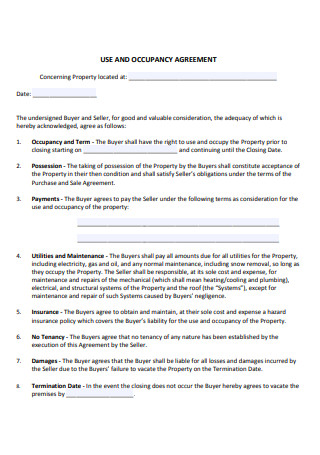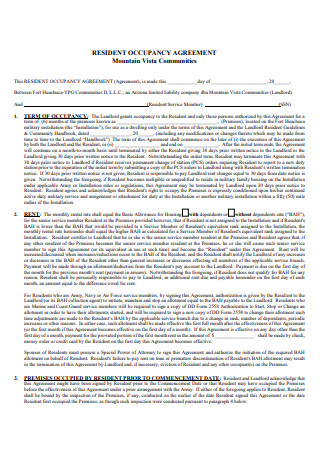43+ Sample Occupancy Agreement
-

Occupancy Agreement Template
download now -

Sample Occupancy Agreement
download now -

Seller Occupancy Agreement
download now -

Basic Occupancy Agreement
download now -

Pre-Closing Occupancy Agreement
download now -

Cooperative Occupancy Agreement
download now -

Buyer Occupancy Agreement
download now -

Formal Occupancy Agreement
download now -

Post Closing Occupancy Agreement
download now -

Commercial Occupancy Agreement
download now -

Emergency Occupancy Agreement
download now -

Occupancy Agreement in PDF
download now -

Shared and Occupancy Agreement
download now -

Assignment of Occupancy Agreement
download now -

Standard Occupancy Agreement
download now -

Mutual Occupancy Agreement
download now -

Closing Occupancy Agreement
download now -

Interim Occupancy Agreement
download now -

Member Occupancy Agreement
download now -

Occupancy Agreement Example
download now -

Site Occupancy Agreement
download now -

Employee Occupancy Agreement
download now -

Post Settlement Occupancy Agreement Template
download now -

Occupancy Agreement Format
download now -

Temporary Certificate of Occupancy Agreement
download now -

Living Occupancy Agreement
download now -

Occupancy Agreement Contract
download now -

Simple Occupancy Agreement
download now -

Occupancy License Agreement
download now -

Master Limited Occupancy Agreement
download now -

Non-Exclusive Occupancy Agreement
download now -

Occupancy Agreement Policy
download now -

Public Property Occupancy Agreement
download now -

Pet Occupancy Agreement
download now -

Resident Occupancy Agreement
download now -

Holdover Occupancy Agreement
download now -

Right of Way Occupancy Agreement
download now -

Purchaser Pre-Settlement Occupancy Agreement
download now -

Printable Occupancy Agreement
download now -

Post Recordation Occupancy Agreement
download now -

Draft Occupancy Agreement
download now -

Occupancy of Dwelling Agreement
download now -

Temporary Occupancy Agreement
download now -

Occupancy Agreement in DOC
download now
What Is an Occupancy Agreement?
An occupancy agreement, commonly referred to as the use and occupancy agreement (U&O), is a temporary agreement between a buyer and seller, allowing the client to utilize and occupy the property for a set term. The occupancy agreement caters to buyers wanting to move into the property before transferring ownership from the seller to the new owner. It is worth noting that the U&O allows the property owner to remain within the home for a definite period, even after the closing. Many sellers utilize this strategy knowing that inventory is low in the industry, leaving sellers to have a difficult time finding another property.
According to the statistical data published by S. Lock on Statista, dating June 1st, 2021, a prediction for the fourth quarter of 2022 shows figures about the occupancy rate of the United States lodging industry to reach 59.2 percent. Numbers are still dropping compared to the estimates during the first half of 2019, showing more or less 70 percent before the COVID-19 pandemic.
Components of an Occupancy Agreement
As with many other similar documents and agreements, an occupancy agreement does not have a standard format. However, these papers have commonalities in the terms and conditions to ensure that the record satisfies both parties’ needs and expectations while protecting them equally from lawsuits and other legal implications. Below are the standard components you can see in an occupancy agreement.
How To Create an Effective Occupancy Agreement
Remember that an occupancy agreement represents a legal document. With that being said, it must be well-structured, and the preparation must be overseen by a real estate agent or a real estate attorney to ensure that all parties are fairly represented and have sufficient insight. Below are helpful tips you and the other party can take while drafting an efficient occupancy agreement.
Tip 1: Put the Agreement in Writing
It is the most useful step in creating an occupancy agreement. In any agreement, it needs to be written down on paper, including an occupancy agreement. It also pays to have someone knowledgeable with you and the other party when drafting this legal document, whether it is a professional attorney or real estate agent. Most contracts are not final within a day as there are further negotiations about terms, conditions, and clauses. It ensures you maximize what you want your agreement to contain.
Tip 2: Maintain a Reasonable Timeframe
Most use and occupancy agreements adhere to shorter durations. If the buyer wants to stay for prolonged periods, the home’s marketability can plummet. It is reasonable to stick to a maximum term of 30 days, especially if there are several homes in the market. Having a wide selection of properties and homes puts the buyer in a more advantageous position. Remember to reiterate the maximum number of days within the written mutual agreement.
Tip 3: Fix a Daily Rate for the Homebuyer
Think of the daily rate as a rent payment or a hotel bill. Being the homeowner, you must choose fair and efficient compensation for you and the buyer for using the property. Remember that choosing the daily rate over one flat rate for your occupancy fees can prove advantageous if your client wishes to extend their stay. It tells you how much the other party owes by providing them the figure of the daily payment they must give.
Tip 4: Be Clear and Fair on the Contents
If the homeowner plans on staying in the property for a particular period, it must be indicated in the occupancy agreement. If you also plan on staying in the property when the agreement comes to a close, it is necessary to highlight the homeowner’s insurance, even if the ownership transfers to the buyer. The purpose of the insurance is to protect the property and the furnishings inside. Including all these provisions allow the buyer to have a clear understanding of the terms within the agreement.
Tip 5: Be Specific
In writing the occupancy agreement, the more specific your terms are, the better. Ensure you have set a clear length for your agreement and explicitly state the conditions even after the completion date of the agreement. It is also useful to indicate guidelines that you want homebuyers to observe while under the terms of the agreement. It may list information about the do’s and don’t within the property, like not making major renovations or changes during their stay and something as simple as bringing their pets within the home.
Tip 6: Complete a Final Walk-Through of the Property Before Closing
Final walk-throughs are usually done before a buyer settles into the property for them to see its initial condition. However, it is also necessary to have a final walk-through of the property before a buyer’s closing date approaches. It helps the seller to point out damages or complications in the property during the homebuyer’s stay. It is ideal to have a signoff and another walk-through before the seller turns over the property and the buyer takes acquisition. In this way, the transfer of ownership and financial liabilities is straightforward.
FAQs
Is an occupancy similar to rent?
A seller calls a buyer an occupant in an occupancy agreement. On the other hand, in a rental agreement, they are referred to as tenants. In terms of approval, a landlord can accept or deny occupant status. Minors and dependents are classified as occupants rather than tenants as they do not have the capacity to bind themselves in a contract. When creating agreements, tenants assume more responsibilities and liabilities compared to tenants. In terms of repairs or renovations, tenants have the right to negotiate and request particular changes to the property while an occupant must maintain the property as-is. When contracts end, tenants must present a 30-day to 60-day notice before moving out of their apartments, while occupants do not need to provide notices before moving out.
What is a permitted occupant?
A permitted occupant is someone that is not a tenant but has the permission to stay within a property. Occupants have minimal to no legal rights within the property, nor are they obligated to pay the rent to the landlord. Most permitted occupants settle with tenants within a leased property, with the tenant being fully responsible for their actions. Permitted occupiers are individuals that can be the tenant’s partner, child, or an older relative that stays either for a while or prolonged durations.
When do you use an occupancy agreement?
During unforeseen and unavoidable circumstances, a buyer can decide to move into a property before the closing deadline, and one of the reasons point to the delay of the closing. The postponement is often associated with delay in financing mortgages, or the homebuyer has the possibility of being homeless because they already sold their property and need to secure another within the same day. Another reason is that a client is undergoing relocation, and the only options they have are staying at the property of purchase or going to a hotel or rental home. One of the other reasons individuals partake in an occupancy agreement is that they have kids that must enroll their kids to a school that has a system that requires proof of residency.
Occupancy agreements have their advantages and disadvantages. Before engaging in any arrangement, ensure you weigh down this knowledge. If you think it’ll be more beneficial to engage in an occupancy agreement rather than a lease or rental agreement, you must ensure that it is propitious to you. As a seller, you must also remember to safeguard yourself from legal liabilities and guarantee there are clauses and statements clearly written on the agreement. As it is a legal document, seeking help from experts, including real estate agents and lawyers, will be advantageous when drafting the arrangement. In the words of former US President Barack Obama, “Don’t be afraid to ask questions. Don’t be afraid to ask for help when you need it. I do that every day. Asking for help isn’t a sign of weakness, it’s a sign of strength. It shows you have the courage to admit when you don’t know something, and to learn something new.” Go through the selection of occupancy agreement samples above for your use and download, and start drafting your document today.
